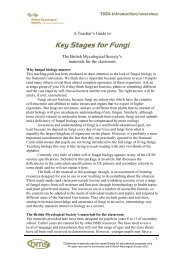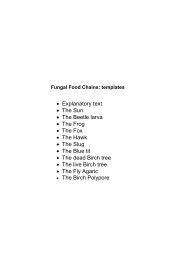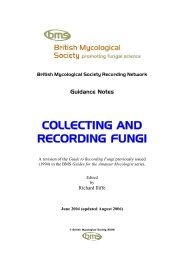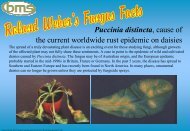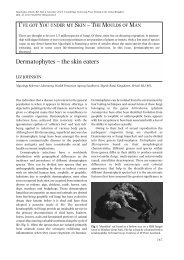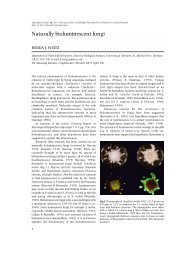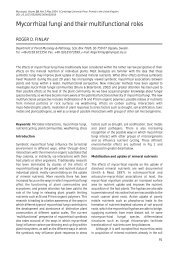Welcome to the World of Fungi - fungi4schools
Welcome to the World of Fungi - fungi4schools
Welcome to the World of Fungi - fungi4schools
You also want an ePaper? Increase the reach of your titles
YUMPU automatically turns print PDFs into web optimized ePapers that Google loves.
WF01<br />
<strong>Welcome</strong> <strong>to</strong> <strong>the</strong> <strong>World</strong> <strong>of</strong> <strong>Fungi</strong><br />
In <strong>the</strong> beginning<br />
‘Can you believe that fungi have been around on earth longer than<br />
humans?’<br />
► Earth is approximately 4.6 billion years old.<br />
► Humans have been on earth for about 200,000 years.<br />
► <strong>Fungi</strong> have been on earth for about 500 million years.<br />
<strong>Fungi</strong> are so <strong>to</strong>ugh and well adapted <strong>to</strong> <strong>the</strong>ir environment that <strong>the</strong>y<br />
outlived <strong>the</strong> dinosaurs. The scientists that study fungi (mycologists)<br />
have so far identified more than 100,000 species, but estimate that<br />
<strong>the</strong>re could be 1.5 million species all over <strong>the</strong> world.<br />
►Question: Why do you think not all species have been found?<br />
There are so many living organisms on earth that scientists have<br />
classified <strong>the</strong>m in<strong>to</strong> 5 kingdoms:<br />
1. Animals<br />
2. Plants<br />
3. Bacteria<br />
4. Protists<br />
5. <strong>Fungi</strong><br />
[Note: all those names are plural. If you have one mushroom, it is a<br />
fungus; if you have two <strong>the</strong>y are fungi.]<br />
This document may be copied freely for educational purposes only.<br />
All rights reserved for commercial use. Text © Charlotte Quinn 2005; design and production © David Moore 2005.<br />
1
WF01<br />
Let’s focus on fungi<br />
What do you think <strong>of</strong> when you read <strong>the</strong> word.........fungi?<br />
........................... mushrooms and <strong>to</strong>ads<strong>to</strong>ols?<br />
These answers are correct, but <strong>the</strong>y aren’t <strong>the</strong> only answers.<br />
Bacteria are called prokaryotes whilst fungi are eukaryotes and<br />
may be single celled (yeast) or filamen<strong>to</strong>us and multicellular (with<br />
100s or 1000s <strong>of</strong> cells.)<br />
Filamen<strong>to</strong>us multicellular fungi include:<br />
mushrooms and <strong>to</strong>ads<strong>to</strong>ols<br />
moulds<br />
cup fungi<br />
bracket fungi<br />
…and lots <strong>of</strong> o<strong>the</strong>rs<br />
They all have different:<br />
sizes<br />
shapes<br />
colours<br />
smells<br />
textures<br />
From Fungus Fred Goes Foraying by Margaret Hadley<br />
This document may be copied freely for educational purposes only.<br />
All rights reserved for commercial use. Text © Charlotte Quinn 2005; design and production © David Moore 2005.<br />
2
WF01<br />
What are <strong>Fungi</strong> Made <strong>of</strong>?<br />
If you pull a shop-bought mushroom apart with your fingers you’ll<br />
see that <strong>the</strong> body <strong>of</strong> <strong>the</strong> mushroom is made up <strong>of</strong> a network <strong>of</strong><br />
threads or fibres – <strong>the</strong>se are called hyphae. A hypha is<br />
characteristic <strong>of</strong> fungi. It is a long, growing tube.<br />
Draw and label diagrams <strong>of</strong> an animal cell and a hypha in this box.<br />
Animal Cell<br />
Hypha<br />
The large network <strong>of</strong> hyphae is called <strong>the</strong> mycelium. It is<br />
responsible for finding food sources for <strong>the</strong> fungus.<br />
From The <strong>Fungi</strong> Name Trail by Liz Holden & Kath Hamper<br />
This document may be copied freely for educational purposes only.<br />
All rights reserved for commercial use. Text © Charlotte Quinn 2005; design and production © David Moore 2005.<br />
3
WF01<br />
Growth <strong>of</strong> a mushroom occurs in different stages. The mycelium<br />
grows under <strong>the</strong> soil, searching for food.<br />
This searching and branching outwards develops <strong>the</strong> mycelial network.<br />
Only when conditions are correct, does <strong>the</strong> mycelia grow upwards<br />
out <strong>of</strong> <strong>the</strong> soil <strong>to</strong> produce a mycelial knot that eventually grows in<strong>to</strong><br />
<strong>the</strong> visible mushroom.<br />
►Experiment: How <strong>the</strong> Mushroom got its Spots. Try <strong>the</strong><br />
experiment in <strong>the</strong> booklet for yourself <strong>to</strong> learn a bit more about<br />
mushroom growth.<br />
<strong>Fungi</strong> can be:<br />
1. Single celled<br />
OR<br />
2. Septate<br />
OR<br />
3. Aseptate<br />
Use this box <strong>to</strong> draw and label diagrams <strong>of</strong> a single celled fungus (yeast), a septate<br />
fungal hypha, and an aseptate fungal hypha.<br />
This document may be copied freely for educational purposes only.<br />
All rights reserved for commercial use. Text © Charlotte Quinn 2005; design and production © David Moore 2005.<br />
4
WF01<br />
Why aren’t <strong>Fungi</strong> Plants?<br />
Draw and label diagrams <strong>of</strong> a plant cell and a hypha in this box. Label <strong>the</strong>m <strong>to</strong> remind yourself<br />
how <strong>the</strong>y compare with one ano<strong>the</strong>r.<br />
Plant Cell<br />
Cellulose cell wall<br />
Chloroplasts<br />
Fungal hypha<br />
Cell wall made <strong>of</strong> chitin<br />
No chloroplasts<br />
KEY DIFFERENCE:<br />
Feeding.<br />
► Plants make <strong>the</strong>ir own food, converting light energy gained from<br />
<strong>the</strong> sun in<strong>to</strong> chemical energy, using <strong>the</strong>ir chloroplasts. This is<br />
called pho<strong>to</strong>syn<strong>the</strong>sis.<br />
► Animals engulf <strong>the</strong>ir food (even individual animal cells do this).<br />
► <strong>Fungi</strong> secrete enzymes in<strong>to</strong> <strong>the</strong>ir food <strong>to</strong> digest it externally; <strong>the</strong>y<br />
<strong>the</strong>n absorb <strong>the</strong> small molecules produced by <strong>the</strong> digestion as<br />
<strong>the</strong>ir nutrients.<br />
This document may be copied freely for educational purposes only.<br />
All rights reserved for commercial use. Text © Charlotte Quinn 2005; design and production © David Moore 2005.<br />
5
WF01<br />
<strong>Fungi</strong> differ in <strong>the</strong> way <strong>the</strong>y feed. They can be:<br />
1. Saprotrophic (obtaining <strong>the</strong>ir nutrients by decomposing<br />
[and <strong>the</strong>refore recycling] dead organic materials)<br />
2. Symbiotic (in a close, mutually-beneficial relationship with<br />
ano<strong>the</strong>r organism)<br />
3. Parasitic (living on or in ano<strong>the</strong>r organism (<strong>the</strong> ‘host’) and<br />
taking <strong>the</strong>ir nutrients from <strong>the</strong> host; this may injure and may kill<br />
<strong>the</strong> host).<br />
From The <strong>Fungi</strong> Name Trail by Liz Holden & Kath Hamper<br />
This document may be copied freely for educational purposes only.<br />
All rights reserved for commercial use. Text © Charlotte Quinn 2005; design and production © David Moore 2005.<br />
6
WF01<br />
Hyphal growth is characteristic <strong>of</strong> fungi<br />
Hyphae grow at <strong>the</strong>ir tips; <strong>the</strong>y search for areas in <strong>the</strong> soil which<br />
contain plenty <strong>of</strong> food. They don’t engulf <strong>the</strong>ir food like animals, so<br />
how does <strong>the</strong> food enter <strong>the</strong> hyphae?<br />
The answer is enzymes digest <strong>the</strong> food outside <strong>the</strong><br />
hyphae. Special enzymes are released (secreted) from <strong>the</strong> hyphal<br />
tips and can break down large complex food in<strong>to</strong> smaller soluble<br />
food that <strong>the</strong> hyphae can <strong>the</strong>n absorb.<br />
Where are <strong>Fungi</strong> Found?<br />
Fields<br />
Forest floor<br />
On trees<br />
Back garden<br />
On ships<br />
Window frames<br />
Cheese and bread (food)<br />
Between your <strong>to</strong>es<br />
In your mouth<br />
On your skin<br />
Obvious?<br />
Not so obvious?<br />
►Question: How many uses for fungi can you think <strong>of</strong>?<br />
SAFETY<br />
Some fungi are edible, but some are POISONOUS<br />
If you find a fungus growing wild<br />
DON’T EAT IT<br />
DON’T TOUCH IT<br />
<br />
This document may be copied freely for educational purposes only.<br />
All rights reserved for commercial use. Text © Charlotte Quinn 2005; design and production © David Moore 2005.<br />
7
WF01<br />
Find <strong>the</strong> correct explanation <strong>to</strong> complete <strong>the</strong><br />
statement.<br />
Draw a line linking <strong>the</strong> start <strong>of</strong> <strong>the</strong> sentence in <strong>the</strong> left-hand column with <strong>the</strong> end <strong>of</strong><br />
<strong>the</strong> sentence in <strong>the</strong> right-hand column.<br />
1. <strong>Fungi</strong> are… …special enzymes that break down<br />
complex food in<strong>to</strong> smaller soluble<br />
food.<br />
2. Fungal parasites... …500 million years ago.<br />
3. Fungal decomposers... …feed <strong>of</strong>f living trees and plants<br />
and can sometimes kill <strong>the</strong>m.<br />
4. Fungal symbionts… …break down dead wood, plant and<br />
animal material.<br />
5. <strong>Fungi</strong> can be found... …eukaryotes.<br />
6. <strong>Fungi</strong> feed via... …make physical links with ano<strong>the</strong>r<br />
organism. Both benefit from <strong>the</strong><br />
relationship.<br />
7. <strong>Fungi</strong> first appeared on<br />
earth...<br />
…(a) in woodland areas, (b)<br />
between our <strong>to</strong>es, (c) on ships.<br />
This document may be copied freely for educational purposes only.<br />
All rights reserved for commercial use. Text © Charlotte Quinn 2005; design and production © David Moore 2005.<br />
8
WF02<br />
Reproduction and Conservation<br />
Rewind . . . . . . . . .<br />
During last lesson we discussed how and where fungi grow.<br />
Let’s go one step fur<strong>the</strong>r on and focus on how fungi reproduce.<br />
As this simplified diagram shows, <strong>the</strong> fruiting body produces spores<br />
(process called sporulation); <strong>the</strong>se <strong>the</strong>n germinate after <strong>the</strong>y arrive<br />
in <strong>the</strong>ir ideal environment (which might be soil, or a leaf surface, or<br />
some rotting leaves, etc.) and begin <strong>to</strong> produce hyphae and <strong>the</strong>n <strong>the</strong><br />
mycelial network. Fur<strong>the</strong>r growth produces <strong>the</strong> hyphal knot and<br />
eventually <strong>the</strong> fruiting body. Spores are released and <strong>the</strong> whole<br />
process starts all over again.<br />
Do you remember that plant reproduction can be sexual or<br />
asexual? Well, it’s just <strong>the</strong> same for fungi <strong>to</strong>o.<br />
► Most fungi reproduce both sexually and asexually<br />
► Some reproduce only sexually<br />
► And <strong>the</strong> rest reproduce only asexually<br />
This document may be copied freely for educational purposes only.<br />
All rights reserved for commercial use. Text © Charlotte Quinn 2005; design and production © David Moore 2005.<br />
1
WF02<br />
Recap . . . . . . . . .<br />
Sexual Reproduction:<br />
Asexual Reproduction:<br />
Involves <strong>the</strong> mixing and<br />
recombination <strong>of</strong> genetic material from<br />
two parents <strong>of</strong> opposite sexes.<br />
Produces genetically different<br />
<strong>of</strong>fspring.<br />
Process includes : cell fusion, nuclear<br />
fusion, recombination, meiosis and<br />
mi<strong>to</strong>sis.<br />
Involves copies <strong>of</strong> only a single parent<br />
being made.<br />
Produces genetically identical<br />
<strong>of</strong>fspring.<br />
Process includes : NO cell fusion, NO<br />
nuclear fusion, and ONLY mi<strong>to</strong>sis.<br />
Cell cycles in Summary:<br />
This document may be copied freely for educational purposes only.<br />
All rights reserved for commercial use. Text © Charlotte Quinn 2005; design and production © David Moore 2005.<br />
2
WF02<br />
Where are Spores Produced?<br />
Answer: from <strong>the</strong> hymenium ►<br />
The tissue layer <strong>of</strong> <strong>the</strong> fruiting<br />
body that contains spore-making<br />
cells.<br />
Let’s look at <strong>the</strong> mushroom as an example...........<br />
From The <strong>Fungi</strong> Name Trail by Liz Holden & Kath Hamper<br />
These three structures (named in <strong>the</strong> picture above) are all covered<br />
with <strong>the</strong> hymenium tissue layer that contains and releases spores.<br />
This document may be copied freely for educational purposes only.<br />
All rights reserved for commercial use. Text © Charlotte Quinn 2005; design and production © David Moore 2005.<br />
3
WF02<br />
What about o<strong>the</strong>r fungal structures?<br />
From The <strong>Fungi</strong> Name Trail From The <strong>Fungi</strong> Name Trail<br />
Birch Polypore<br />
Pip<strong>to</strong>porus betulinus<br />
Yellow Stagshorn<br />
Calocera viscosa<br />
This bracket fungus<br />
releases spores from pores<br />
underneath its cap<br />
While this coral fungus can<br />
release spores from pores<br />
all over its body<br />
This document may be copied freely for educational purposes only.<br />
All rights reserved for commercial use. Text © Charlotte Quinn 2005; design and production © David Moore 2005.<br />
4
WF02<br />
How are Spores Dispersed?<br />
To ensure survival <strong>of</strong> <strong>the</strong> species, a fungus must produce and<br />
release spores as quickly as possible. These spores must be<br />
dispersed over large areas <strong>to</strong> avoid competition. There are many<br />
ways in which dispersal can occur:<br />
► Wind<br />
► Rain<br />
► Insects<br />
► Mechanical Processes<br />
Wind ► Amanita muscaria is an example <strong>of</strong> <strong>the</strong> type <strong>of</strong> mushroom<br />
that releases spores from gills (vertical plates <strong>of</strong> tissue underneath<br />
<strong>the</strong> cap). The spores fall from <strong>the</strong> gills under <strong>the</strong> cap and are <strong>the</strong>n<br />
carried away by air currents. They can be spread over large<br />
distances by <strong>the</strong> wind.<br />
© Charlotte Quinn 2005<br />
This document may be copied freely for educational purposes only.<br />
All rights reserved for commercial use. Text © Charlotte Quinn 2005; design and production © David Moore 2005.<br />
5
WF02<br />
Rain ► The cup fungus Crucibulum vulgare or Bird’s Nest Fungus<br />
has its spores dispersed by rain fall. Raindrops fall in<strong>to</strong> <strong>the</strong> fungus<br />
fruit body and <strong>the</strong> rain splash forces <strong>the</strong> spores out and away from<br />
<strong>the</strong> fruit body.<br />
© Charlotte Quinn 2005<br />
Insects ► The spores <strong>of</strong> <strong>the</strong> Stinkhorn fungus, Phallus impudicus,<br />
are formed in a slimy secretion on <strong>the</strong> bell-shaped tip <strong>of</strong> <strong>the</strong> fruiting<br />
body. The fungus generates a foul smell – like rotting meat. Flies are<br />
attracted <strong>to</strong> <strong>the</strong> strong smell and <strong>the</strong> spores are transferred on<strong>to</strong><br />
<strong>the</strong>ir legs and body and deposited where <strong>the</strong> fly next lands.<br />
© Charlotte Quinn 2005<br />
This document may be copied freely for educational purposes only.<br />
All rights reserved for commercial use. Text © Charlotte Quinn 2005; design and production © David Moore 2005.<br />
6
WF02<br />
Mechanical Processes ► When <strong>the</strong> ball shaped fruit body <strong>of</strong> a<br />
puffball or earth star (like Geastrum) is disturbed (by an animal or by<br />
twigs, leaves or rain drops falling on it) <strong>the</strong> impact increases <strong>the</strong> air<br />
pressure inside and millions <strong>of</strong> spores are forced out on a jet <strong>of</strong> air<br />
that emerges through <strong>the</strong> pore on <strong>to</strong>p.<br />
© Charlotte Quinn 2005<br />
Conservation and Management<br />
All fungal species are extremely important for <strong>the</strong> maintenance <strong>of</strong><br />
our planet. We have already discussed <strong>the</strong> role <strong>of</strong> fungi as<br />
decomposers - removing dead organic matter by breaking it down<br />
using enzymes.<br />
►Question for class discussion : What would happen if fungi<br />
didn’t exist?<br />
You know quite a bit about what fungi do in nature, so think about it<br />
and imagine: what would happen if all fungi were killed <strong>of</strong>f<br />
<strong>to</strong>morrow?<br />
This document may be copied freely for educational purposes only.<br />
All rights reserved for commercial use. Text © Charlotte Quinn 2005; design and production © David Moore 2005.<br />
7
WF02<br />
Food webs show <strong>the</strong> many different types <strong>of</strong> plants, fungi and<br />
animals <strong>of</strong> a particular ecosystem. From <strong>the</strong>m, we can understand<br />
<strong>the</strong> feeding patterns and energy flow within this system.<br />
Use this box <strong>to</strong> draw an example <strong>of</strong> a food web (including fungi):<br />
This document may be copied freely for educational purposes only.<br />
All rights reserved for commercial use. Text © Charlotte Quinn 2005; design and production © David Moore 2005.<br />
8
WF02<br />
The Decline <strong>of</strong> Kingdom <strong>Fungi</strong>?<br />
Reports from all over Europe suggest that in recent years <strong>the</strong>re have<br />
been serious declines in <strong>the</strong> numbers <strong>of</strong> mushrooms and o<strong>the</strong>r fungi<br />
found in <strong>the</strong> forests. The question is: WHY?<br />
There are several reasons; including:<br />
► Increased large-scale picking <strong>of</strong> wild mushrooms for commercial sale<br />
• Air pollution<br />
• Acid rain<br />
► Pollution is a major<br />
• Water contamination from fertilizer ‘run-<strong>of</strong>f’<br />
fac<strong>to</strong>r because <strong>of</strong>:<br />
• Desertification (e.g. around <strong>the</strong><br />
Mediterranean Sea)<br />
► Clearing <strong>of</strong> woodland areas<br />
► Lack <strong>of</strong> understanding <strong>of</strong> <strong>the</strong> roles <strong>of</strong> fungi in nature<br />
Save your fungi!<br />
The problems have been identified, so let’s focus on <strong>the</strong> solutions:<br />
► Obey <strong>the</strong> law:<br />
► Respect and caution:<br />
► Conservation areas:<br />
► Management:<br />
• The Theft Act (1968)<br />
• The Wildlife and Countryside Act 1981)<br />
both protect wildlife <strong>to</strong> some extent, and o<strong>the</strong>r<br />
legislation may apply <strong>to</strong> prevent picking<br />
Respect <strong>the</strong> natural habitat – avoid<br />
unnecessary damage and disturbance<br />
Some countries have vast areas protected by<br />
conservation controls<br />
Government guidelines for fertilizer usage in<br />
agriculture. On a larger scale, <strong>the</strong> Kyo<strong>to</strong><br />
Agreement – carbon emission control<br />
To save your fungi you might have <strong>to</strong> save<br />
<strong>the</strong> forest!<br />
This document may be copied freely for educational purposes only.<br />
All rights reserved for commercial use. Text © Charlotte Quinn 2005; design and production © David Moore 2005.<br />
9
WF03<br />
My Favourite or Nastiest Fungus<br />
Rewind . . . . . . . . . . .<br />
So far we have discussed <strong>the</strong> basics <strong>of</strong> fungi; what <strong>the</strong>y are,<br />
<strong>the</strong>ir many sizes and shapes, growth, reproduction and conservation<br />
issues. Now it’s over <strong>to</strong> you!<br />
►Task:<br />
To work in a group <strong>of</strong> 2 <strong>to</strong> 5 people and produce a<br />
poster which illustrates your favourite or nastiest<br />
fungus.<br />
Where do we start?<br />
► The best poster wins a prize ◄<br />
• The first part <strong>of</strong> your task involves looking for information on<br />
<strong>the</strong> Internet. Six fungal names are provided on <strong>the</strong> next page<br />
along with website addresses you can access from your<br />
school computer room.<br />
• The second part involves making <strong>the</strong> poster. You can present<br />
it any way you like (remember <strong>the</strong> best one gets a prize.)<br />
►Get creative◄<br />
Your poster MUST provide <strong>the</strong> following information:<br />
► Common and scientific name <strong>of</strong> your chosen fungus<br />
► A drawing with <strong>the</strong> structures labelled<br />
► Where and when it is found<br />
► How it feeds - is it a decomposer, saprotroph or parasite?<br />
► Why it is your group’s favourite or nastiest fungus<br />
This document may be copied freely for educational purposes only.<br />
All rights reserved for commercial use. Text © Charlotte Quinn 2005; design and production © David Moore 2005.<br />
1
WF03<br />
Fungal names<br />
We suggest you look for <strong>the</strong> following (but that doesn’t s<strong>to</strong>p<br />
you looking for o<strong>the</strong>rs…)<br />
1. Amanita muscaria<br />
The Fly Agaric<br />
2. Marasmius oreades<br />
Fairy Ring Champignon or Fairy Ring Fungus<br />
3. Phallus impudicus<br />
Stinkhorn fungus<br />
4. Pip<strong>to</strong>porus betulinus<br />
Bracket Fungus<br />
5. Amanita pan<strong>the</strong>rina<br />
The Pan<strong>the</strong>r<br />
6. Aleuria aurantia<br />
Orange Peel<br />
Websites<br />
www.MushroomExpert.com<br />
Click on ‘Site Index.’<br />
www.agarics.org<br />
Click on ‘Database.’<br />
www.herbarium.usu.edu<br />
Click on ‘Fun Facts about <strong>Fungi</strong>.’<br />
www.mykoweb.com<br />
Click on ‘California <strong>Fungi</strong>’ and <strong>the</strong>n click on ‘Species Index.’<br />
This document may be copied freely for educational purposes only.<br />
All rights reserved for commercial use. Text © Charlotte Quinn 2005; design and production © David Moore 2005.<br />
2
WF03<br />
www.first-nature.com/fungi<br />
Click on ‘Identity Parade’<br />
For Aleuria aurantia select Ascomycetes.<br />
For Phallus impudicus select Gasteromycetes.<br />
For Amanita muscaria select Amanitaceae.<br />
For Amanita pan<strong>the</strong>rina select Amanitaceae.<br />
For Pip<strong>to</strong>porus betulinus select Poriales.<br />
Table showing our fungus names and where information about <strong>the</strong>m can<br />
be found.<br />
Name Mykoweb Mush.Expert Agarics First-Nature<br />
A. muscaria + + + +<br />
M. oreades + + +<br />
Ph. impudicus + + +<br />
P. betulinus + +<br />
A. pan<strong>the</strong>rina + + +<br />
Al. aurantia + + +<br />
This document may be copied freely for educational purposes only.<br />
All rights reserved for commercial use. Text © Charlotte Quinn 2005; design and production © David Moore 2005.<br />
3
WF04<br />
<strong>Fungi</strong> and Industry<br />
We have already discussed one major importance <strong>of</strong> Kingdom<br />
<strong>Fungi</strong>: <strong>the</strong>y are decomposers and help remove dead organic matter<br />
from our ecosystems. We will now go one step fur<strong>the</strong>r and discuss<br />
how fungi and fungal products help us directly.<br />
What is Biotechnology?<br />
Biotechnology: industries use microbes, like bacteria and fungi<br />
that produce extremely useful substances. Some <strong>of</strong> <strong>the</strong>se products<br />
are beneficial <strong>to</strong> our health and wellbeing.<br />
►Question:<br />
Can you think <strong>of</strong> any products that depend on<br />
<strong>the</strong> use <strong>of</strong> fungi at any stage during<br />
manufacture?<br />
Use <strong>the</strong> box below <strong>to</strong> make a table listing those you can think <strong>of</strong>:<br />
This document may be copied freely for educational purposes only.<br />
All rights reserved for commercial use. Text © Charlotte Quinn 2005; design and production © David Moore 2005.<br />
1
WF04<br />
Fermentation and Yeast<br />
► Yeast is a single-celled fungus<br />
► with oxygen (called aerobic respiration)<br />
► Yeast can respire: ► without oxygen (called anaerobic<br />
respiration)<br />
► During anaerobic conditions, yeast ferments sugar <strong>to</strong> produce<br />
alcohol, carbon dioxide and water in <strong>the</strong> process <strong>of</strong> fermentation.<br />
► Equation: Yeast + Glucose Alcohol + Carbon dioxide + Water<br />
[NOTE: that <strong>the</strong> same chemistry is used in brewing and baking fermentations, but<br />
brewing uses <strong>the</strong> alcohol, and baking uses <strong>the</strong> carbon dioxide.]<br />
Brewing Industry ►<br />
Baking Industry ►<br />
Myco-protein ►<br />
Brewer’s yeast (Saccharomyces cerevisiae)<br />
ferments sugars in cereal grains <strong>to</strong> produce<br />
alcohol, in addition <strong>to</strong> various o<strong>the</strong>r products,<br />
producing beers and lagers.<br />
Baker’s yeast (Saccharomyces cerevisiae)<br />
ferments sugars in <strong>the</strong> flour, but this time carbon<br />
dioxide is <strong>the</strong> useful product <strong>of</strong> fermentation.<br />
When <strong>the</strong> yeast in bread dough releases carbon<br />
dioxide it makes bubbles in <strong>the</strong> dough and<br />
causes <strong>the</strong> dough <strong>to</strong> ‘rise’ (increase in volume).<br />
The alcohol produced evaporates during baking.<br />
The product called Quorn is myco-protein. It is<br />
NOT a yeast or a mushroom, but a filamen<strong>to</strong>us<br />
fungus called Fusarium venenatum. Mycoprotein<br />
is used as an alternative <strong>to</strong> meat in<br />
health- and vegetarian products.<br />
Find out more about <strong>the</strong> benefits <strong>of</strong> Myco-protein (Quorn) and<br />
discuss <strong>the</strong>m. Find <strong>the</strong> information that will enable you <strong>to</strong> complete<br />
<strong>the</strong> table below with <strong>the</strong> amounts <strong>of</strong> each ingredient:<br />
Myco-protein<br />
Beef steak<br />
Protein Dietary Fibre Fat<br />
This document may be copied freely for educational purposes only.<br />
All rights reserved for commercial use. Text © Charlotte Quinn 2005; design and production © David Moore 2005.<br />
2
WF04<br />
Supermarket Challenge<br />
Earlier we asked you <strong>to</strong> list some products that depend on <strong>the</strong> use <strong>of</strong><br />
fungi in <strong>the</strong>ir manufacture. The table below includes a few you may<br />
not have thought <strong>of</strong>. Find out HOW <strong>the</strong>y depend on fungi and write<br />
some notes in <strong>the</strong> last column <strong>of</strong> <strong>the</strong> table.<br />
Marmite ►<br />
Fizzy Drinks ►<br />
Soy Sauce ►<br />
Chocolate and<br />
C<strong>of</strong>fee ►<br />
This document may be copied freely for educational purposes only.<br />
All rights reserved for commercial use. Text © Charlotte Quinn 2005; design and production © David Moore 2005.<br />
3
WF04<br />
Local Industry<br />
There are probably companies close <strong>to</strong> you and your school<br />
that use fungi or fungal products in <strong>the</strong>ir manufacturing<br />
processes. You could use local business direc<strong>to</strong>ries <strong>to</strong> find out<br />
about <strong>the</strong>m and <strong>the</strong>n look at <strong>the</strong>ir websites <strong>to</strong> get more<br />
information.<br />
Here’s an unusual example:<br />
The British Textile Technology Group (BTTG) is based in Didsbury<br />
in Manchester and works with <strong>the</strong> Welsh School <strong>of</strong> Pharmacy in<br />
Cardiff. Toge<strong>the</strong>r <strong>the</strong>y have designed and produced a range <strong>of</strong><br />
filamen<strong>to</strong>us fungal materials that help with <strong>the</strong> healing <strong>of</strong> wounds.<br />
When you cut your finger you’ll probably use a plaster <strong>to</strong> cover<br />
it up until it’s healed. Even if you had a deep cut and had <strong>to</strong> go <strong>to</strong><br />
hospital, <strong>the</strong> nurses would place a sterile pad over <strong>the</strong> wound and<br />
bandage it up. What <strong>the</strong>se companies have produced incorporates<br />
filamen<strong>to</strong>us fungi (<strong>the</strong> mycelial network) <strong>to</strong> produce a plaster with a<br />
difference:<br />
► The secret’s in <strong>the</strong> chitin (which maintains <strong>the</strong> rigidity and<br />
structure <strong>of</strong> fungal cell walls).<br />
► Many experiments have been conducted which suggest<br />
that chitin can speed up <strong>the</strong> healing <strong>of</strong> wounds.<br />
► It is thought that chitin actually encourages <strong>the</strong> growth <strong>of</strong><br />
fibroblasts in<strong>to</strong> <strong>the</strong> wound. Fibroblasts help build new tissue.<br />
► The process has <strong>the</strong> potential <strong>to</strong> treat chronic ulcers and<br />
bed sores in hospital patients.<br />
► If a patient’s wounds heal faster <strong>the</strong>n hospital and nursing<br />
resources will be saved.<br />
► Discuss: Can you think <strong>of</strong> any o<strong>the</strong>r uses for this product?<br />
This document may be copied freely for educational purposes only.<br />
All rights reserved for commercial use. Text © Charlotte Quinn 2005; design and production © David Moore 2005.<br />
4
WF04<br />
How Can <strong>Fungi</strong> Benefit Our Health?<br />
None <strong>of</strong> <strong>the</strong> products we have discussed so far are really essential<br />
for survival. Believe it or not, we can survive without chocolate and<br />
our favourite fizzy drinks! These products are manufactured for our<br />
enjoyment and <strong>to</strong> improve <strong>the</strong> quality <strong>of</strong> life.<br />
However, for some people fungal products are really needed <strong>to</strong> treat<br />
infections, prevent serious diseases, or <strong>to</strong> improve poor diet. Some<br />
<strong>of</strong> <strong>the</strong>se essential products are in <strong>the</strong> form <strong>of</strong>:<br />
► Antibiotics<br />
► Statins<br />
► Immunosuppressives<br />
► Vitamins<br />
Use <strong>the</strong> information in <strong>the</strong> tables below as class discussion points.<br />
Antibiotics are used <strong>to</strong> treat bacterial and<br />
fungal infections. You probably know about<br />
penicillin -produced by <strong>the</strong> mould<br />
Penicillium notatum and discovered by<br />
Alexander Fleming in 1928. O<strong>the</strong>r examples<br />
<strong>of</strong> antibiotics derived from fungi are:<br />
Antibiotics ► Cephalosporin from Cephalosporium sp.<br />
and Grise<strong>of</strong>ulvin from Penicillium<br />
grise<strong>of</strong>ulvum and Penicillium patulum.<br />
Today, most antibiotics used in medicine are<br />
derived from bacteria. Antibiotics produced<br />
by bacteria include strep<strong>to</strong>mycin and<br />
terramycin.<br />
► Discuss <strong>the</strong> effect <strong>of</strong> ‘wonder drugs’ on society (imagine <strong>the</strong> effect if<br />
antibiotics were not available). Discuss <strong>the</strong> effect <strong>of</strong> resistance <strong>to</strong> <strong>the</strong> drug<br />
in <strong>the</strong> disease-causing organism (e.g. newspaper s<strong>to</strong>ries about MRSA).<br />
How might you combat that? What’s involved in finding new antibiotics?<br />
This document may be copied freely for educational purposes only.<br />
All rights reserved for commercial use. Text © Charlotte Quinn 2005; design and production © David Moore 2005.<br />
5
WF04<br />
Statins are products <strong>of</strong> metabolic reactions<br />
in fungi. Lovastatin comes from Aspergillus<br />
terreus strains; mevastatin from Penicillium<br />
citrinum. Statins inhibit an enzyme involved<br />
in <strong>the</strong> syn<strong>the</strong>sis <strong>of</strong> cholesterol and <strong>the</strong>y’ve<br />
Statins ►<br />
become very important for control <strong>of</strong><br />
cholesterol levels in patients. Cholesterol is<br />
made in <strong>the</strong> liver, but we also get it from our<br />
food. Diets high in fat result in a build up <strong>of</strong><br />
cholesterol in <strong>the</strong> arteries and this can lead<br />
<strong>to</strong> heart attacks or strokes.<br />
► Discuss <strong>the</strong> influence <strong>of</strong> food on health and <strong>the</strong> use <strong>of</strong> medicines <strong>to</strong><br />
control metabolism. Can you think <strong>of</strong> o<strong>the</strong>r examples?<br />
Immunosuppressives<br />
►<br />
Immune suppressants are essential for<br />
organ transplant patients. The T cells <strong>of</strong> <strong>the</strong><br />
human immune system recognise <strong>the</strong> new<br />
organ as ‘foreign’ and begin <strong>to</strong> destroy <strong>the</strong><br />
organ. The filamen<strong>to</strong>us fungus called<br />
Tolypocladium inflatum was found <strong>to</strong><br />
produce Cyclosporin A. This drug prevents<br />
organ rejection by inhibiting T cell activation.<br />
► Discuss <strong>the</strong> ethics <strong>of</strong> organ donation and transplantation. What’s<br />
involved in giving permission for a deceased loved-one’s organs <strong>to</strong> be<br />
used for transplantation? Discuss <strong>the</strong> impact (on people and <strong>the</strong>ir<br />
families) <strong>of</strong> life-long, life-preserving medication.<br />
All fungi are a good source <strong>of</strong> vitamins.<br />
Brewer’s yeast syn<strong>the</strong>sises B group<br />
vitamins; so yeast extract and yeast tablets<br />
Vitamins ►<br />
are popular vitamin supplements. In industry<br />
<strong>the</strong> fungi Nema<strong>to</strong>spora gossypii and<br />
Eremo<strong>the</strong>cium ashbyi are now used <strong>to</strong><br />
produce B vitamins.<br />
► Discuss <strong>the</strong> general use <strong>of</strong> food supplements. Compare fresh and<br />
processed foods, and children and adults – are supplements needed? Are<br />
any safety issues raised?<br />
This document may be copied freely for educational purposes only.<br />
All rights reserved for commercial use. Text © Charlotte Quinn 2005; design and production © David Moore 2005.<br />
6
WF05<br />
Recap. . . . . . .<br />
<strong>Fungi</strong> and Disease<br />
Bacteria, fungi and viruses are all micro organisms. We<br />
learnt last lesson that some fungal species are beneficial <strong>to</strong> humans<br />
in <strong>the</strong> food industry and in medicine production.<br />
However, some fungal species can cause disease along with<br />
bacteria and viruses. Micro organisms that cause disease are called<br />
pathogens.<br />
Let’s Focus on <strong>Fungi</strong><br />
Certain fungi have <strong>the</strong> ability <strong>to</strong> cause diseases in humans,<br />
plants and animals.<br />
When looking at plant pathogens it’s important <strong>to</strong> remember<br />
that some parts <strong>of</strong> <strong>the</strong> plant are above ground – stems and leaves<br />
and o<strong>the</strong>r parts are below ground – roots. So, it makes sense that<br />
airborne pathogenic fungi infect <strong>the</strong> stems and leaves and soil borne<br />
pathogenic fungi infect plant roots.<br />
Plant diseases have some very strange names! They are<br />
given names like:<br />
► Blights<br />
► Rusts<br />
► Smuts<br />
► Mildews<br />
Most <strong>of</strong> <strong>the</strong>se names come from old descriptions <strong>of</strong> <strong>the</strong> effect<br />
on <strong>the</strong> crop and were given <strong>to</strong> <strong>the</strong> disease long before its cause was<br />
known. Mildew is a cot<strong>to</strong>ny covering on <strong>the</strong> leaf (on which dew forms<br />
readily). A crop that looks sick and dying might be described as<br />
being ‘blighted’; plants covered in red masses (actually fungal<br />
spores) as being ‘rusted’; or if covered in black deposits (spores<br />
again) like soot, <strong>the</strong>n it’s a ‘smut’ or a ‘tarspot’.<br />
This document may be copied freely for educational purposes only.<br />
All rights reserved for commercial use. Text © Charlotte Quinn 2005; design and production © David Moore 2005.<br />
1
WF05<br />
Some Examples <strong>of</strong> Plant Diseases<br />
This is a tarspot disease <strong>of</strong><br />
sycamore leaves. Caused by a<br />
fungus called Rhytisma acerinum<br />
which is very common and<br />
widely distributed. You can see<br />
this on sycamore leaves<br />
throughout <strong>the</strong> year.<br />
© Paul Dyer<br />
This is <strong>the</strong> rust disease <strong>of</strong> wild<br />
and cultivated daisies caused by<br />
Puccinia distincta. An epidemic<br />
<strong>of</strong> this disease started in <strong>the</strong> mid-<br />
1990s and spread from Australia,<br />
through Europe, and in<strong>to</strong> North<br />
America. In many places,<br />
ornamental daisies can no longer<br />
be grown unless <strong>the</strong>y are<br />
protected by fungicide sprays.<br />
© David Moore<br />
This is ‘eyespot’ disease on<br />
wheat stems, caused by a<br />
fungus with <strong>the</strong> wonderful name<br />
<strong>of</strong> Pseudocercosporella<br />
herpotrichoides. It’s a serious<br />
disease <strong>of</strong> cereals because it<br />
survives from year <strong>to</strong> year on<br />
stubble debris, and can even<br />
survive being ploughed under<br />
and ploughed up again <strong>the</strong><br />
following season.<br />
© Roland Weber<br />
This document may be copied freely for educational purposes only.<br />
All rights reserved for commercial use. Text © Charlotte Quinn 2005; design and production © David Moore 2005.<br />
2
WF05<br />
Human diseases caused by fungi are called mycoses. The<br />
diseases are divided in<strong>to</strong> three groups depending on where <strong>the</strong>y<br />
occur on our body. These groups are:<br />
Superficial ►<br />
Subcutaneous ►<br />
Systemic ►<br />
These infect <strong>the</strong> skin, nails and hair.<br />
These infect <strong>the</strong> deep layers <strong>of</strong> <strong>the</strong> skin.<br />
These are <strong>the</strong> most severe fungal diseases.<br />
An unsuspecting person may inhale <strong>the</strong><br />
pathogenic fungal spores. Some spores stay<br />
in <strong>the</strong> lungs and grow while o<strong>the</strong>rs enter <strong>the</strong><br />
bloodstream, travel around <strong>the</strong> body and<br />
infect o<strong>the</strong>r organs.<br />
Most fungal infections are due <strong>to</strong> opportunistic pathogens;<br />
<strong>the</strong>se affect people who are already ill or have a suppressed<br />
immune system (e.g. in patients who have been given an organ<br />
transplant, or in AIDS patients). In a perfectly healthy person <strong>the</strong><br />
fungus would not normally cause disease. True pathogens can<br />
cause disease in even <strong>the</strong> healthiest person.<br />
Like bacteria, fungi can produce <strong>to</strong>xins. Fungal <strong>to</strong>xins are<br />
called myco<strong>to</strong>xins and <strong>the</strong> diseases <strong>the</strong>y cause are called<br />
myco<strong>to</strong>xicoses. Several food items are particularly susceptible <strong>to</strong><br />
fungal disease including bread, dried pasta, peanuts and s<strong>to</strong>red<br />
grains and cereals. All <strong>of</strong> <strong>the</strong>se are dry foods which should be s<strong>to</strong>red<br />
in dry conditions. When s<strong>to</strong>red in <strong>the</strong> wrong conditions <strong>of</strong> high<br />
temperature and high humidity, myco<strong>to</strong>xins can be found as a result<br />
<strong>of</strong> fungal (‘mould’) growth in <strong>the</strong> s<strong>to</strong>red material.<br />
The most widespread and dangerous <strong>of</strong> <strong>the</strong>se are <strong>the</strong><br />
afla<strong>to</strong>xins produced by <strong>the</strong> mould called Aspergillus flavus. These<br />
are carcinogenic, which means <strong>the</strong>y can cause cancer. Afla<strong>to</strong>xins<br />
pose a serious threat <strong>to</strong> both humans and domestic animals<br />
because <strong>the</strong> mould grows on poorly-s<strong>to</strong>red grain and animal feed.<br />
When eaten, <strong>the</strong> <strong>to</strong>xin is s<strong>to</strong>red in <strong>the</strong> liver where it can eventually<br />
cause hepatitis and liver cancer.<br />
This document may be copied freely for educational purposes only.<br />
All rights reserved for commercial use. Text © Charlotte Quinn 2005; design and production © David Moore 2005.<br />
3
WF05<br />
Some Examples <strong>of</strong> Human Diseases<br />
Ringworm is not a worm, but a<br />
common fungus infection <strong>of</strong> <strong>the</strong> skin.<br />
The fungus (<strong>of</strong>ten one called<br />
Microsporum) does not invade living<br />
tissue but <strong>the</strong> fungus and its<br />
metabolic products cause<br />
inflammation. This 5-week old baby<br />
caught <strong>the</strong> disease from contact with<br />
<strong>the</strong> family’s pet cats. Image courtesy <strong>of</strong> www.doc<strong>to</strong>rfungus.org © 2005<br />
Epidermophy<strong>to</strong>n floccosum<br />
causes athlete’s foot in humans –<br />
usually in <strong>the</strong> web area between<br />
<strong>to</strong>es – and is common in shoewearing<br />
people because it’s<br />
favoured by warm, humid<br />
conditions. It can also affect <strong>the</strong><br />
hand and o<strong>the</strong>r areas <strong>of</strong> <strong>the</strong> body,<br />
Image courtesy <strong>of</strong> www.doc<strong>to</strong>rfungus.org © 2005 and here is attacking <strong>to</strong>e-nails.<br />
This is a Madurella myce<strong>to</strong>ma on a patient’s<br />
limb. This disease occurs all over <strong>the</strong> world, but<br />
is most common in tropical and sub-tropical<br />
regions. It is caused by a number <strong>of</strong> fungi<br />
including Madurella, Acremonium, Curvularia,<br />
Fusarium and Aspergillus.<br />
Image courtesy <strong>of</strong><br />
www.doc<strong>to</strong>rfungus.org © 2005<br />
Image courtesy <strong>of</strong> www.doc<strong>to</strong>rfungus.org © 2005<br />
These are skin ulcers <strong>of</strong> a<br />
patient suffering from<br />
blas<strong>to</strong>mycosis (caused by<br />
Blas<strong>to</strong>myces dermatidis). The<br />
disease starts in <strong>the</strong> lungs<br />
when spores are inhaled, and<br />
<strong>the</strong>n spreads <strong>to</strong> o<strong>the</strong>r organs.<br />
This document may be copied freely for educational purposes only.<br />
All rights reserved for commercial use. Text © Charlotte Quinn 2005; design and production © David Moore 2005.<br />
4
WF05<br />
His<strong>to</strong>ry Lesson!<br />
An important example that demonstrates just how devastating<br />
pathogens <strong>of</strong> our crops can be is <strong>the</strong> Irish Pota<strong>to</strong> Famine <strong>of</strong> 1845 -<br />
46.<br />
The organism responsible was a relative <strong>of</strong> <strong>the</strong> fungi called<br />
pota<strong>to</strong> blight or Phy<strong>to</strong>phthora infestans – even <strong>the</strong> scientific name<br />
means ‘infesting plant destroyer’! The whole <strong>of</strong> Europe was affected<br />
with <strong>the</strong> disease (which was introduced on plants imported from <strong>the</strong><br />
Americas) but Ireland suffered more because <strong>the</strong> poorest people<br />
lived entirely on a diet <strong>of</strong> pota<strong>to</strong>es. English labourers were less<br />
affected because <strong>the</strong>y had cereal foods in <strong>the</strong>ir diet and cereal crops<br />
were not affected by <strong>the</strong> disease. For <strong>the</strong> majority <strong>of</strong> <strong>the</strong> Irish,<br />
though, if <strong>the</strong>re were no pota<strong>to</strong>es <strong>the</strong>y starved. Sadly, from 1845 <strong>to</strong><br />
1860 a staggering 1 million people died as a direct consequence <strong>of</strong><br />
<strong>the</strong> famine, and over 2 million emigrated (many <strong>to</strong> <strong>the</strong> USA).<br />
So what can we learn from this tragic incident?<br />
►<br />
►<br />
►<br />
►<br />
Grow more than one crop. Growing a single crop plant over<br />
vast areas (called monoculture) encourages disease <strong>to</strong> spread<br />
rapidly. Also, populations should not be entirely dependent on<br />
a single source <strong>of</strong> food.<br />
Use <strong>of</strong> fungicides will prevent or at least control disease. Of<br />
course, in <strong>the</strong> mid-nineteenth century <strong>the</strong> cause <strong>of</strong> ‘pota<strong>to</strong><br />
blight’ was not known because <strong>the</strong> ‘germ <strong>the</strong>ory’ <strong>of</strong> disease<br />
(that is, <strong>the</strong> idea that diseases are caused by infections) had<br />
not even been suggested in 1845.<br />
S<strong>to</strong>re in <strong>the</strong> correct conditions: this means proper control <strong>of</strong><br />
humidity, oxygen and temperature. It doesn’t have <strong>to</strong> mean<br />
high technology – what’s required is good aeration and careful<br />
protection from rain and ground water.<br />
Wea<strong>the</strong>r conditions play in important part in <strong>the</strong> spread <strong>of</strong> crop<br />
disease.<br />
This document may be copied freely for educational purposes only.<br />
All rights reserved for commercial use. Text © Charlotte Quinn 2005; design and production © David Moore 2005.<br />
5



